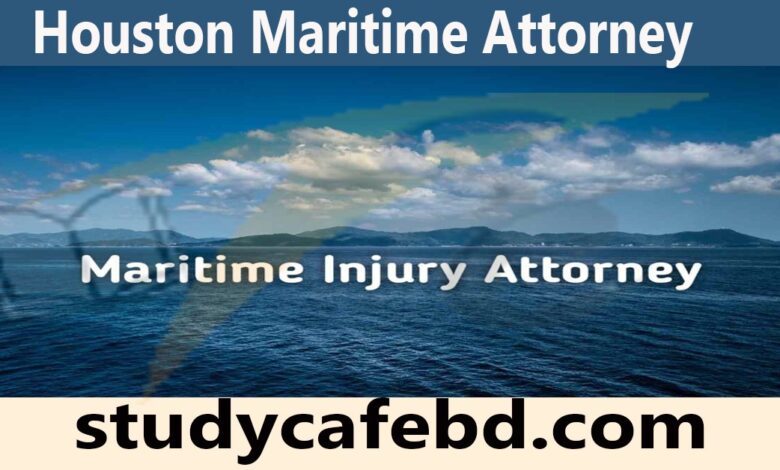Houston Maritime Attorney : Types of Maritime and Act of Maritime in 2022

Table of Contents
HOUSTON MARITIME ACCIDENT LAWYER: Act of Houston Maritime Attorney lawyer
Houston Maritime Attorney: Working on the seas and in the Gulf is dangerous business, but it’s a job that’s absolutely essential to Houston, Texas and the U.S. economy. Despite the inherent danger, risks can be minimized. Workers must take caution, and employers must take precautions. When maritime employers fail to take reasonable and adequate steps to protect their employees, they can be held liable for injuries caused under any number of applicable laws of Houston Maritime Attorney.
Knowing which law applies to a particular accident and how to proceed to obtain maximum compensation for the injured worker is a complicated matter. The Houston maritime accident attorneys at Livingston & Flowers combine decades of experience with knowledge and skill in personal injury to help fisherman, seamen, offshore oil workers and others recover valuable compensation to cover their medical expenses, lost wages, pain and suffering and other applicable legal damages. Houston Maritime Attorney
Houston Maritime Attorney: Different Types of Maritime Vessels
There are many different varieties of ships and the differences are mostly based upon the type of cargo the ship transports. Knowing the different types can be really helpful since each ship is unique in itself with quite similarities in between. In this article, Porto cargo will provide a brief overview of the foremost types of maritime vessels that are plying the oceans nowadays.
1. Ro-Ro Vessels
There are many different varieties of ships and the differences are mostly based upon the type of cargo the ship transports. Porto cargo will provide a brief overview of the foremost types of maritime vessels that are plying the oceans nowadays. Houston Maritime Attorney international freight transport, Import and Export of Goods, international trade agreement, exporting local products, importing local products
Roll on-Roll off or Ro-Ro vessels come in many forms including vehicle ferries and cargo ships carrying truck trailers but the major type used for the transport of road vehicles is the car carrier. These slab-sided vessels feature multiple vehicle decks comprising parking lanes, linked by internal ramps with access to the shore provided by one or more loading ramp.
2. Dry Cargo Ships
Dry cargo vessels were the mainstay of the world’s merchant fleet. Known as general cargo vessels, they would be “geared”, that is one of many types of maritime vessels equipped with their own cargo loading equipment, usually in the form of derricks. Such ships would sometimes operate a regular service between two or more ports as “liners”, but could also operate in the “tramp trade” where vessels would go wherever they were required. Houston Maritime Attorney
3. General Cargo Vessels
Although largely replaced by bulk and container carriers, general cargo vessels still operate throughout the world. There may be specialized handling facilities for such cargo, but usually loading and unloading are carried out using cranes and straps (for boxes) or slings (for bags). Cargo is usually in the form of pallets or bags and is known as breakbulk.
4. Bulk Carriers
There are many different varieties of ships and the differences are mostly based upon the type of cargo the ship transports. Porto cargo will provide a brief overview of the foremost types of maritime vessels that are plying the oceans nowadays. international freight transport, Import and Export of Goods, international trade agreement, exporting local products, importing local products
For dry cargoes with a high weight to cost ratio such as coal, grain, and ore, economies of scale have produced the modern bulk carrier. These usually large vessels are divided up into several separate holds covered by hatches. One of the many different types of maritime vessels, on this one, cargo will usually be unloaded into hoppers and will then be transferred by conveyor to silos or open storage, smaller vessels may discharge directly into road vehicles. Houston Maritime Attorney
5. Reefer Vessels
Reefer Vessels are ships designed to carry a refrigerated cargo usually comprising perishable goods such as fruit or meat. Cargo is stowed in holds which are then sealed and temperature controlled. Nowadays, traditional reefer vessels have been largely replaced by the use of reefer containers which may be carried on board a container vessel.
Keep learning all about the different types of maritime vessels! Houston Maritime Attorney
6. Container Vessels
There are many different varieties of ships and the differences are mostly based upon the type of cargo the ship transports. Portocargo will provide a brief overview of the foremost types of maritime vessels that are plying the oceans nowadays. | international freight transport, Import and Export of Goods, international trade agreement, exporting local products, importing local products
Container vessels have become the main way of transporting manufactured goods around the world. A container can be transferred between truck, train, and ship relatively easily and is a standard size to simplify transportation. Containers can accommodate anything from foodstuffs to electrical equipment to automobiles. Containers are also used to transport bagged and palletized goods, liquids, and refrigerated cargo. Container vessels are used predominantly on liner routes and are some of the biggest vessels afloat. Houston Maritime Attorney
7. Liquid Cargo Ships
These vessels, collectively known as tankers, carry a range of liquid cargoes. Tankers were first developed in the mid-nineteenth century when the use of iron allowed liquids to be carried in bulk economically and without leakage. Like the case of the bulk carrier, economies of scale have driven up the size of tankers and today the largest examples have a carrying capacity or “deadweight” of over 400,000 tons.
8. Crude Carriers
There are many different varieties of ships and the differences are mostly based upon the type of cargo the ship transports. Portocargo will provide a brief overview of the foremost types of maritime vessels that are plying the oceans nowadays. Houston Maritime Attorney international freight transport, Import and Export of Goods, international trade agreement, exporting local products, importing local products
The largest ships afloat are the Very Large Crude Carriers (VLCCs) and the Ultra Large Crude Carriers (ULCCs). These types of maritime vessels are designed to load crude oil and transport it to refineries around the world where it can be processed into petroleum products. The largest crude carriers often load and unload at offshore buoys and terminals as they are too large to enter most ports. Houston Maritime Attorney
9. Product Carriers
Product carriers vessels, which are generally smaller than crude carriers, transport the refined products from larger terminals to smaller ports around the world. Products carried can include petroleum, jet fuel, diesel, asphalt, lubricating oil, and tar. Smaller tankers are also used to transport non-petroleum bulk liquids such as molasses and palm oil.
10. Chemical Carriers
Chemical carriers ships usually have a deadweight of 5,000-40,000 tons and often have specialized cargo systems suited to the type of cargo carried. These systems can include heating or cooling apparatus and advanced cleaning systems to ensure the purity of cargo is maintained when loaded into a tank that may have previously carried something different.
11. Liquefied Gas Carriers
There are many different varieties of ships and the differences are mostly based upon the type of cargo the ship transports. Portocargo will provide a brief overview of the foremost types of maritime vessels that are plying the oceans nowadays. | international freight transport, Import and Export of Goods, international trade agreement, exporting local products, importing local products Houston Maritime Attorney.
Another one among the different types of maritime vessels, Liquefied gas carriers ships began as converted oil tankers but have evolved into highly specialized purpose-built vessels. Designed to carry Liquefied Petroleum Gas (LPG) or Liquefied Natural Gas (LNG) under pressure, the cargo tanks are generally spherical for strength. LNG carriers are usually larger than those carrying LPG, the largest LNG carriers are the ‘Q-Flex’ vessels with a gas capacity of up to 266,000 cubic meters.
12. Specialized Cargoes
Most types of cargo could be considered as specialized cargoes due to the specific loading, unloading or storage arrangements required. Many such cargoes are, however, moved with such regularity and ease that the term ‘specialized’ takes on a new meaning.
13. Passenger Vessels
There are many different varieties of ships and the differences are mostly based upon the type of cargo the ship transports. Portocargo will provide a brief overview of the foremost types of maritime vessels that are plying the oceans nowadays. | international freight transport, Import and Export of Goods, international trade agreement, exporting local products, importing local products
Passenger vessels category includes everything from 10 person foot ferries up to cruise ships able to carry over 6,000 passengers. Nowadays, cruise passengers demand and expect a wide range of facilities including casinos, gymnasiums, shops, theatres, cinemas, pools, restaurants, and bars. Houston Maritime Attorney
14. Tugs
Modern tugs vessels are highly maneuverable with pulling power (bollard pull) sometimes in excess of 100 tonnes, although harbor tugs are generally much less powerful. This kind of ship is also used to assist the most maneuverable vessels during periods of bad weather or when carrying dangerous or polluting cargoes.
15. Livestock Carriers
Livestock carriers are often converted from other types of maritime vessels and are equipped with pens for large numbers of animals. The main considerations during the transport of livestock are adequate ventilation, food, and water, but also the ability of the reception facilities at the destination port to handle the cargo.
16. Heavy-lift/Project Cargo Vessels
These, mostly purpose-built, vessels specialize in the transport of extremely heavy or bulky objects such as other ships and large industrial components. Some heavy-lift vessels are equipped with high capacity cranes to load at ports without a heavy-lift capability.
Some act of Houston Maritime Attorney lawyer
The Jones Act
Also known as the Merchant Seaman Protection and Relief Act, the Jones Act covers health care expenses and wage replacement to seamen and longshoremen who are injured while they are working on a maritime vessel. Additional compensation, including pain and suffering damages, is available if the worker can prove that the employer’s negligence caused the accident or injury.
Longshore and Harbor Workers’ Compensation Act
Through the LHWCA, dockworkers who are not covered as seamen under the Jones Act may still be compensated for injuries incurred while working on docks, piers and other facilities on U.S. navigable waters. These workers may not be eligible for benefits under Texas workers’ compensation, so the LHWCA may be vital to covering medical costs and wage loss. Houston Maritime Attorney
The Seaworthiness Doctrine
Federal law requires that all ships operating in the U.S. must be seaworthy and safe for their intended purpose. Vessel owners are strictly liable for injuries caused on an unseaworthy vessel. Under strict liability, the injured worker only has to prove that the injury occurred on an unsafe vessel and does not have to prove that the boat owner was negligent. Houston Maritime Attorney
Following are a few examples of conditions that could possibly render a vessel unseaworthy:
- Vessel was defectively designed
- Vessel is undermanned
- Crew members are inadequately trained or supervised
- Safety equipment is missing or defective
- Other tools or equipment are missing or defective
- Decks are unreasonably slippery
- Obstructions on the decks
- Death on the High Seas Act
- When a maritime worker is killed in international waters, this federal admiralty law allows a surviving spouse, child or any other dependent family member to recover compensation for a
- wrongful death which was caused either by negligence or unseaworthiness.
Common Life-Threatening Accidents On Board Ships
1. Man overboard
Man overboard situation is a common and one of the most dangerous situations wherein the person falls into water while working or as a result of some accident.
Though seafarers are trained to deal with such situations, bad weather and heavy sea can spoil the rescue operation. Areas with extremely water temperature can also cause hypothermia or other dangerous health issues, even death. Several people have lost their lives in past because of such accidents.
2. Enclosed Space Accidents
This is one of the most common types of accidents onboard ships, which has been the result of several casualties and extreme injuries. Such accidents occur mainly when the ship’s crew enter a confined space that is not properly gas-freed and has several pockets of toxic/flammable gases. Many officers still neglect the enclosed space entry procedures, risking their and other crew member’s lives. Seafarers must be extremely cautious while entering enclosed spaces.
3. Electrical Shock Accidents
Just like on land, electrical shocks have also taken several lives onboard ships. Unattended electrical connections, exposed wires, and failure in taking basic precautions while handling electrical equipment have to lead to many unfortunate incidents.
4. Machinery Explosion – Generator, compressor, boiler blast etc.
Improperly maintained machinery and systems sometimes leads to major blasts/explosions, destroying the ship’s property and killing people working on and around them. Accidents such as compressor blasts, crankcase explosions, boiler blasts etc. have caused serious injuries and even death in many cases in the past.
5. Mooring Operations
Yet another most common reason for serious injuries and deaths onboard ships, mooring operations is considered an extremely dangerous task that needs proper skills and knowledge. Several officers and crew members lose their lives every year because of accidents related to mooring operations.
6. Falling From Height
Onboard ships, seafarers are often required to work at heights wearing safety harnesses and other important safety tools. However, in spite of taking all the necessary precautions, several crew members have lost their lives or suffered permanent injuries as a result of falling/slipping from heights, failure of safety devices, falling inside cargo hold during the inspection, and also due to sheer negligence.
7. Piracy Attacks
Though this is not a real kind of accident on board ships, it is a situation that is extremely life-threatening. Pirates use lethal weapons such as RPG and guns at the ship’s crew while trying to highjack the vessel. There have also been accidents wherein pirates have boarded the vessel, killed crew members and looted the vessel. They are the least bothered of anyone’s life and can shoot without giving a second thought. Houston Maritime Attorney
8. Lifeboat Testing Accidents
It is said that lifeboats take more lives than they save. Lifeboat testing during drills is an important routine onboard ships. However, several seafarers have lost their lives while performing such tests. Though new regulations have been introduced in order to ensure utmost safety while handling lifeboats, accidents involving severe injuries and deaths still occur as a result of lifeboats.
9. Hot Work Accidents
Accidents as a result of hot work can occur because of several reasons. One of the most common ones is when hot work is being carried out in an enclosed space with flammable gases, when the adjacent tank has flammable material, as a result of flammable gas pockets etc. It is also seen that seafarers often fail to follow the basic hot work procedures while carrying out such procedures, leading to unfortunate, fatal accidents. Houston Maritime Attorney
10. Gangway Fall
Accidents have occurred on many ships when the ship’s gangway has failed while being used by the ship’s crew members or visitors. Gangway failure usually takes place as a result of lack of maintenance and failure of gangway wire rope.
Accidents on board ships can occur as a result of several reasons. The above-mentioned ones are some of the most common life-threatening accidents/situations onboard ships of which seafarers must be aware and careful. Houston Maritime Attorney




